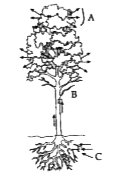Describe the role of any three trace elements with regard to mineral nutrition of plants.
Step-by-Step Solution:
1. Introduction to Trace Elements:
- Trace elements, also known as micronutrients, are essential for plant growth and development. They are required in very small quantities compared to macronutrients.
2. Identifying Three Trace Elements:
- For this question, we will discuss the roles of three trace elements: Boron, Zinc, and Molybdenum.
3. Role of Boron:
- Boron plays a crucial role in the activation of enzymes. It is essential for the synthesis of proteins and helps in the formation of cell walls. Boron also aids in the transport of sugars and the development of reproductive structures in plants.
4. Role of Zinc:
- Zinc is vital for the synthesis of cell walls and is involved in various enzymatic reactions. It plays a significant role in the formation of chlorophyll and is necessary for the proper functioning of many enzymes that facilitate metabolic processes.
5. Role of Molybdenum:
- Molybdenum is essential for nitrogen metabolism in plants. It facilitates the conversion of atmospheric nitrogen into ammonium, which is a form that plants can utilize for growth. This process is crucial for the synthesis of amino acids and proteins.
6. Conclusion:
- In summary, Boron, Zinc, and Molybdenum are three important trace elements that play vital roles in the mineral nutrition of plants, contributing to enzyme activation, cell wall synthesis, and nitrogen metabolism, respectively.
---
- Trace elements, also known as micronutrients, are essential for plant growth and development. They are required in very small quantities compared to macronutrients.
- For this question, we will discuss the roles of three trace elements: Boron, Zinc, and Molybdenum.
- Boron plays a crucial role in the activation of enzymes. It is essential for the synthesis of proteins and helps in the formation of cell walls. Boron also aids in the transport of sugars and the development of reproductive structures in plants.
- Zinc is vital for the synthesis of cell walls and is involved in various enzymatic reactions. It plays a significant role in the formation of chlorophyll and is necessary for the proper functioning of many enzymes that facilitate metabolic processes.
- Molybdenum is essential for nitrogen metabolism in plants. It facilitates the conversion of atmospheric nitrogen into ammonium, which is a form that plants can utilize for growth. This process is crucial for the synthesis of amino acids and proteins.
- In summary, Boron, Zinc, and Molybdenum are three important trace elements that play vital roles in the mineral nutrition of plants, contributing to enzyme activation, cell wall synthesis, and nitrogen metabolism, respectively.
Topper's Solved these Questions
- SAMPLE QUESTION PAPER 3BOOK - ICSECHAPTER - SAMPLE QUESTION PAPER 3EXERCISE - SECTION - C
6 Videos
- SAMPLE QUESTION PAPER 3BOOK - ICSECHAPTER - SAMPLE QUESTION PAPER 3EXERCISE - SECTION - A
9 Videos
- SAMPLE QUESTION PAPER 2 BOOK - ICSECHAPTER - SAMPLE QUESTION PAPER 2 EXERCISE - PART-II SECTION - C
6 Videos
- SAMPLE QUESTION PAPER 4 BOOK - ICSECHAPTER - SAMPLE QUESTION PAPER 4 EXERCISE - Part - II Section - C
9 Videos
Similar Questions
Select the incorrect regarding mineral nutrition in plants.
View SolutionBriefly describe the use of hydroponics to determine the mineral nutrients of a plant.
View SolutionRead the following statements regarding the mineral nutrition in plants
(1) For the elements that are actively mobilized within the plants, the deficiency symptoms tend to appear first in the young tissues.
(2) Manganese competes with iron and magnesium for uptake and with magnesium for binding with enzymes.
(3) Manganese inhibits calcium traslocation in shoot apex.
(4) Rhodospirillum is aerobic free-living nitrogen fixing microbe.
Which of these are correct
View SolutionRead the following statements regarding the mineral nutrition in plants
(1) For the elements that are actively mobilized within the plants, the deficiency symptoms tend to appear first in the young tissues.
(2) Manganese competes with iron and magnesium for uptake and with magnesium for binding with enzymes.
(3) Manganese inhibits calcium traslocation in shoot apex.
(4) Rhodospirillum is aerobic free-living nitrogen fixing microbe.
Which of these are correct
View SolutionPlant nutrition is usually referred to as mineral nutrition. Explain.
View SolutionFind the amount of macronutrients and trace elements that is present in plant tissues.
View SolutionDescribe any three factors affecting growth and development of plants.
View SolutionAn outline sketch of a tree is shown in the diagram below. Study the same and answer the question that follo:

Explain the role of any three external factors that will increase the rate of this phenomenon.
View SolutionDescribe the role of agrobacterium in transforming a plant cell.
View SolutionAbsroption of a mineral element by the plant
View Solution
